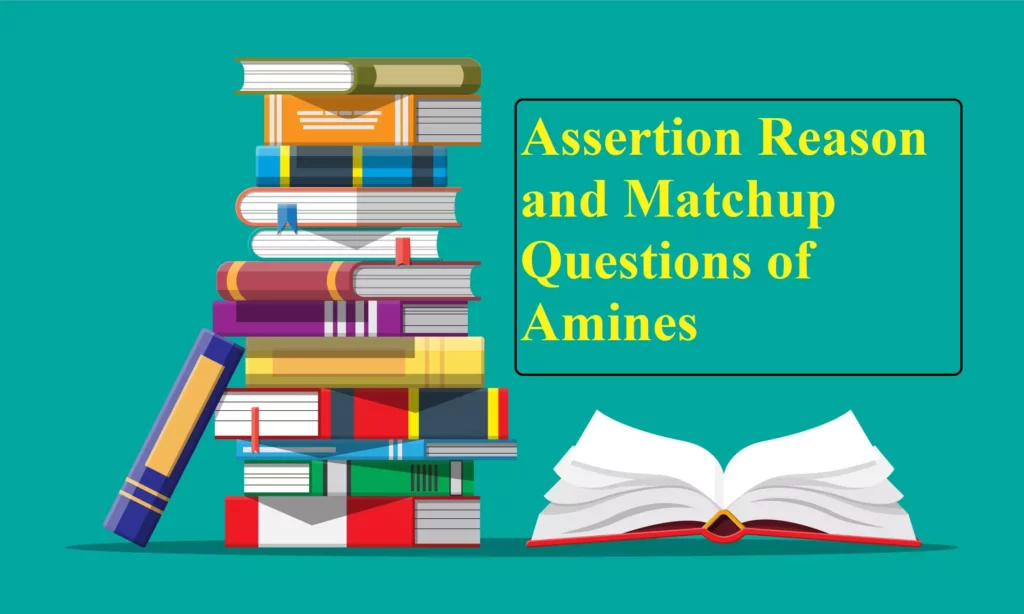Assertion Reason and Matchup Questions of Amines
Assertion Reason and Matchup Questions of Amines:
Note: Match the items of Column I and Column II in the following questions
1. Match the reactions given in Column I with the statements given in Column
| Column I | Column II |
| (i) Ammonolysis | (a) Amine with a lesser number of carbon atoms |
| (ii) Gabriel phthalimide synthesis | (b) Detection test for primary amines. |
| (iii) Hoffmann Bromamide reaction | (c) Reaction of phthalimide with KOH and R—X |
| (iv) Carbylamine reaction | (d) Reaction of alkyl halides with NH3 |
Ans 1. (i)-(d)
(ii)- (c)
(iii)- (a)
(iv)- (b)
Explanation:
(i) This process of cleavage of the C—X bond by ammonia molecule is known as ammonolysis.
(ii) The reaction of phthalimide with KOH and R—X.

(iii) Amine with lesser number of carbon:

(iv) Detection test for primary amines.
![]()
Que 2. Match the compounds given in Column I with the items given in Column II.
| Column I | Column II |
| (i) Benzenesulphonyl chloride | (a) Zwitter ion |
| (ii) Sulphanilic acid | (b) Hinsberg reagent |
| (iii) Alkyl diazonium salts | (c) Dyes |
| (iv) Aryl diazonium salts | (d) Conversion to alcohols |
Ans 2. (i)- (b)
(ii)- (a)
(iii)- (d)
(iv)- (c)
Explanation:

![]()
Assertion Reason and Matchup Questions of Amines
Assertion and Reason Type
Note: In the following questions a statement of assertion followed by a statement of reason is given. Choose the correct answer out of the following choices.
(i) Both assertion and reason are wrong.
(ii) Both assertion and reason are correct statements but the reason is not the correct explanation of assertion.
(iii) Assertion is a correct statement but the reason is a wrong statement.
(iv) Both assertion and reason are correct statements and reason is the correct explanation of assertion.
(v) Assertion is the wrong statement but the reason is a correct statement.
Que 3. Assertion: Acylation of amines gives a mono-substituted product whereas alkylation of amines gives a poly-substituted product.
Reason: Acyl group sterically hinders the approach of further acyl groups.
Ans 3. (iii)
Explanation: Acetylation (or ethanoylation) is the process of introducing an acetyl group into a molecule. Aliphatic and aromatic primary and secondary amines undergo acetylation reaction by nucleophilic substitution when treated with acid chlorides, anhydrides, or esters. This reaction involves the replacement of the hydrogen atom of –NH2 or > NH group by the acetyl group, which in turn leads to the production of amides.
Que 4. Assertion: Hoffmann’s bromamide reaction is given by primary amines.
Reason: Primary amines are more basic than secondary amines.
Ans 4. (iii)
Explanation: Hoffmann developed a method for the preparation of primary amines by treating an amide with bromine in an aqueous or ethanolic solution of sodium hydroxide.
Que 5. Assertion: N-Ethylbenzene sulphonamide is soluble in alkali.
Reason: Hydrogen attached to nitrogen in sulphonamide is strongly acidic.
Ans 5. (iv)
Explanation: The hydrogen attached to nitrogen in sulphonamide is strongly acidic due to the presence of a strong electron-withdrawing sulphonyl group. Hence, it is soluble in alkali.
Que 6. Assertion: N, N-Diethylbenzenesulphonamide is insoluble in alkali.
Reason: Sulphonyl group attached to the nitrogen atom is a strong electron-withdrawing group.
Ans 6. (ii)
Explanation: Since N, N-diethyl benzene sulphonamide does not contain any hydrogen atom attached to a nitrogen atom, it is not acidic and hence insoluble in alkali.
Que 7. Assertion: Only a small amount of HCl is required in the reduction of nitro compounds with iron scrap and HCl in the presence of steam.
Reason: FeCl2 formed gets hydrolyzed to release HCl during the reaction.
Ans 7. (iv)
Explanation: Reduction with iron scrap and hydrochloric acid is preferred because FeCl2 formed gets hydrolyzed to release hydrochloric acid during the reaction. Thus, only a small amount of hydrochloric acid is required to initiate the reaction. Fe + 2HCl >FeCl2 + 2[H]
Nascent hydrogen reduces nitro compounds.
FeCl2 + H2O(g) > FeO + 2HCl
Que 8. Assertion: Aromatic 1° amines can be prepared by Gabriel Phthalimide Synthesis.
Reason: Aryl halides undergo nucleophilic substitution with anion formed by phthalimide.
Ans 8. (i)
Explanation: Gabriel synthesis is used for the preparation of primary amines. Phthalimide on treatment with ethanolic potassium hydroxide forms potassium salt of phthalimide which on heating with alkyl halide followed by alkaline hydrolysis produces the corresponding primary amine. Aromatic primary amines cannot be prepared by this method because aryl halides do not undergo nucleophilic substitution with the anion formed by phthalimide.
Que 9. Assertion: Acetanilide is less basic than aniline.
Reason: Acetylation of aniline results in a decrease of electron density on nitrogen.
Ans 9. (iv)
Explanation: The lone pair of electron on the nitrogen of acetanilide interacts with oxygen atom due to resonance as shown below:
Que 10. A hydrocarbon ‘A’, (C4H8) on reaction with HCl gives a compound ‘B’, (C4H9Cl), which on reaction with 1 mol of NH3 gives compound ‘C’, (C4H11N). On reacting with NaNO2 and HCl followed by treatment with water, compound ‘C’ yields optically active alcohol, ‘D’. Ozonolysis of ‘A’ gives 2 mols of acetaldehyde. Identify compounds ‘A’ to ‘D’. Explain the reactions involved.
Ans 10. The addition of HCl has occurred on ‘A’. This implies ‘A’ is an alkene.
Cl in compound ‘B’ is substituted by NH2 to give ‘C’.

‘C’ gives a diazonium salt with NaNO2/HCl that liberates N2 to give optically active alcohol. This means that ‘C’ is an aliphatic amine. The number of carbon atoms in amine is the same as in compound ‘A’.

Since products of ozonolysis of compound ‘A’ are CH3 — CH — O and O — CH—CH3. The compound ‘A’ is CH3—CH— CH—CH3.
On the basis of the structure of ‘A’ reactions can be explained as follows:

Que 11. A colourless substance ‘A’ (C6H7N) is sparingly soluble in water and gives a water-soluble compound ‘B’ on treating with a mineral acid. On reacting with CHCl3 and alcoholic potash ‘A’ produces an obnoxious smell due to the formation of compound ‘C’. The reaction of ‘A’ with benzenesulphonyl chloride gives compound ‘D’ which is soluble in alkali. With NaNO2 and HCl, ‘A’ forms compound ‘E’ which reacts with phenol in alkaline medium to give an orange dye ‘F’. Identify compounds ‘A’ to ‘F’.
Ans 11.
Que 12. Predict the reagent or the product in the following reaction sequence.
Ans 12.

Assertion Reason and Matchup Questions of Amines









